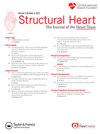经导管主动脉瓣置入术治疗极低梯度主动脉瓣狭窄
IF 1.4
Q3 CARDIAC & CARDIOVASCULAR SYSTEMS
引用次数: 0
摘要
经导管主动脉瓣植入术(TAVI)对低流量、低梯度主动脉瓣狭窄(LGAS)(平均压力梯度[MPG] <;40 mmHg)是有益的。TAVI治疗极低梯度主动脉瓣狭窄(VLGAS)患者(MPG < 25mmhg)的益处和结果报道不足。方法:本回顾性队列研究分析了2012年7月至2021年12月在三级保健中心接受TAVI治疗的1173例严重先天性主动脉瓣狭窄患者。通过经胸超声心动图MPG将患者分为VLGAS(≤25mmhg)、LGAS (25mmhg ~ 40mmhg)和高梯度主动脉狭窄(≥40mmhg)。VLGAS和LGAS被细分为经典低流量、矛盾低流量和正常流量亚组。主要结局是症状改善(通过纽约心脏协会分级改善来衡量)、生活质量改善(通过堪萨斯城心肌病问卷总结评分增加来衡量)、再住院和死亡率。在移植后30天和1年测量结果。结果大多数VLGAS患者经TAVI治疗后症状和生活质量均有改善。VLGAS患者在1年内症状改善的较少(p <;0.01)。VLGAS患者1年再住院率最高(p <;0.01)。所有其他主要结果在两组之间相似。在亚群分析中,1年症状改善仅在正常流量亚组之间存在差异,而再住院和死亡率仅在低流量亚组之间存在差异。结论经导管主动脉瓣置入术改善了包括VLGAS患者在内的LGAS患者的症状和生活质量。VLGAS患者在1年时观察到较低程度的症状改善,主要是由血流状态正常的患者驱动的。仅在经典低流量状态下观察到死亡率和再住院率的差异。本文章由计算机程序翻译,如有差异,请以英文原文为准。
Transcatheter Aortic Valve Implantation in Very Low-Gradient Aortic Stenosis
Background
Transcatheter aortic valve implantation (TAVI) is beneficial in low-flow, low-gradient aortic stenosis (LGAS) (mean pressure gradient [MPG] <40 mmHg). The benefit and outcomes of TAVI in very low-gradient aortic stenosis (VLGAS) patients (MPG <25 mmHg) are under-reported.
Methods
This retrospective cohort study analyzed 1173 patients with severe native valve aortic stenosis who underwent TAVI at a tertiary-care center between July 2012 and December 2021. Patients were divided into VLGAS (≤25 mmHg), LGAS (25 mmHg to 40 mmHg), and high-gradient aortic stenosis (≥40 mmHg) using MPG from transthoracic echocardiography. VLGAS and LGAS were subdivided into classical low-flow, paradoxical low-flow, and normal flow subgroups. The primary outcomes were symptom improvement (measured by New York Heart Association class improvement), quality-of-life improvement (measured by Kansas City Cardiomyopathy Questionnaire Summary Score increase), rehospitalization, and mortality. Outcomes were measured at 30 days and 1 year postimplant.
Results
Most patients with VLGAS had symptom and quality-of-life improvement after TAVI. Fewer patients with VLGAS had symptom improvement at 1 year (p < 0.01). One-year rehospitalization was the highest in VLGAS patients (p < 0.01). All other primary outcomes were similar between groups. In subset analyses, 1-year symptom improvement only differed between normal flow subgroups, while rehospitalization and mortality only differed between low-flow subgroups.
Conclusions
Trascatheter aortic valve implantation improves symptoms and quality of life in LGAS, including those with VLGAS. A lower degree of symptom improvement was observed in VLGAS at 1 year, primarily driven by those with normal flow states. Differences in mortality and rehospitalization were observed only in classical low-flow states.
求助全文
通过发布文献求助,成功后即可免费获取论文全文。
去求助
来源期刊

Structural Heart
Medicine-Cardiology and Cardiovascular Medicine
CiteScore
1.60
自引率
0.00%
发文量
81
 求助内容:
求助内容: 应助结果提醒方式:
应助结果提醒方式:


